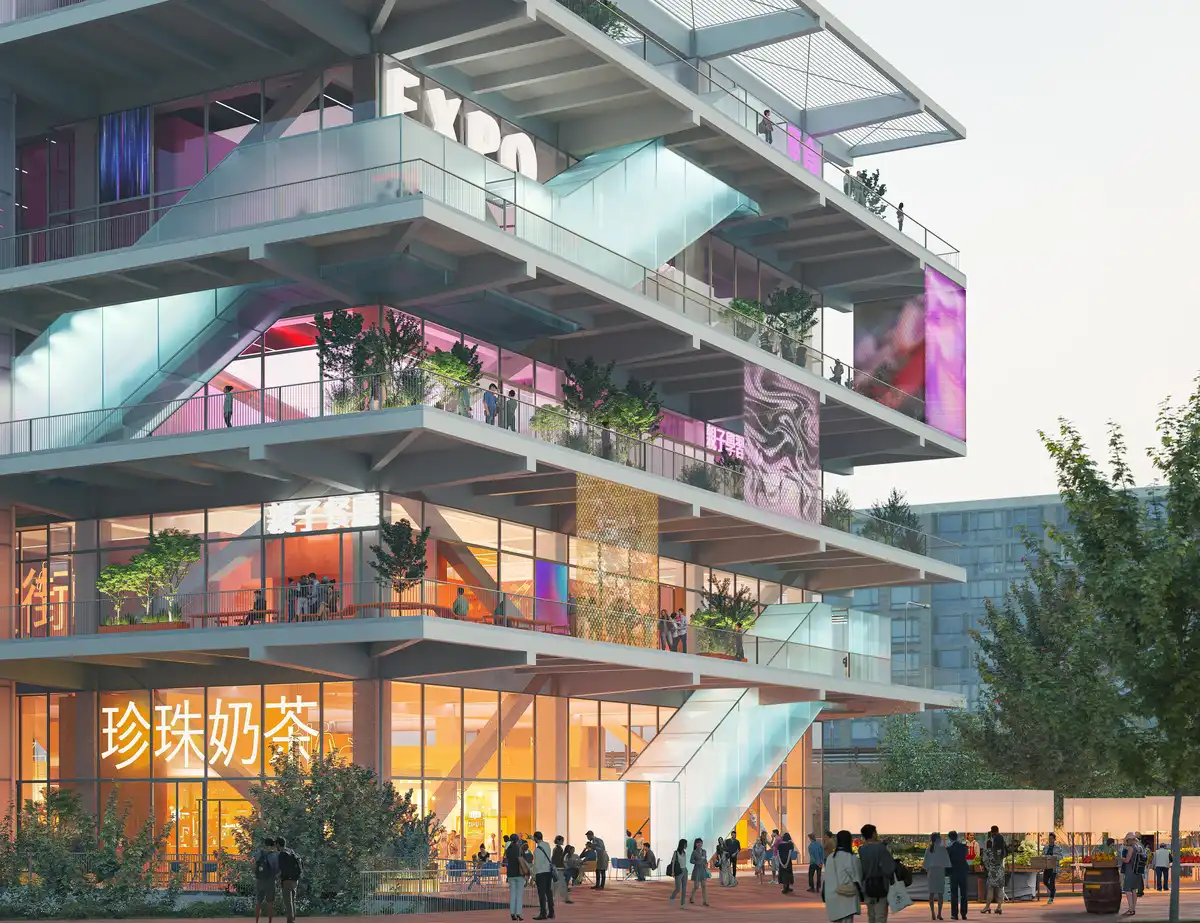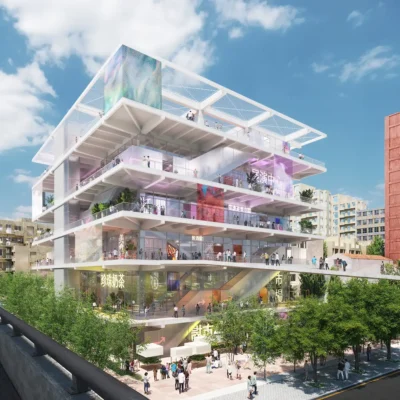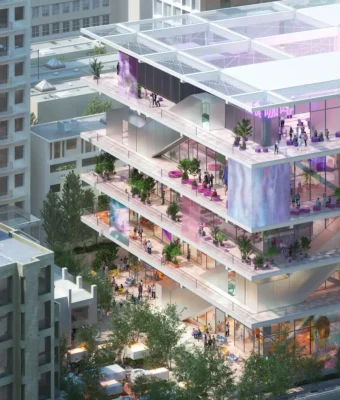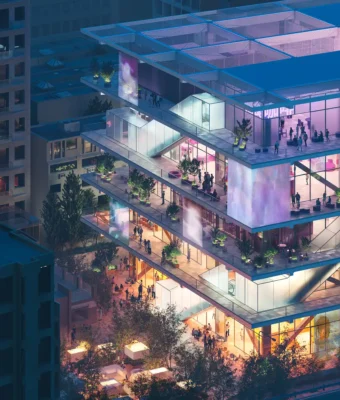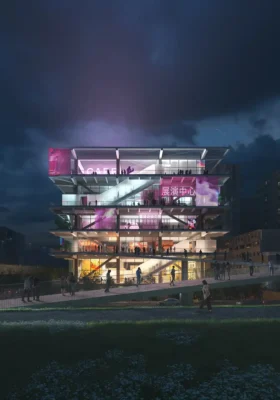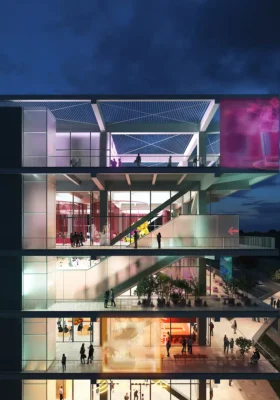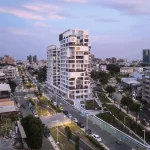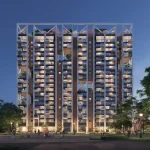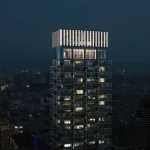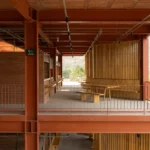Market Cube Zhubei City, Modern Taiwan commercial design images, Architecture competition winners
Market Cube in Taiwan
28 March 2025
Architects: MVRDV
Location: North District, Taiwan
Images by © MVRDV
Market Cube, Zhubei, Taiwan
MVRDV has won a competition to design the Market Cube, a new building in Zhubei, Taiwan that combines a market and food hall with cultural spaces. Standing out next to the Touqian River, the project’s mix of uses will make the new market building a destination within the city. With its stack of open, flexible floors that can adapt to changing demands, the building acts as an urban condenser, and is envisaged as the next step in the evolution of the market. This future-focused vision is reflected in its name: the market square becomes the Market Cube.
Zhubei, in the north of Taiwan, is one of the island’s fastest-growing cities. Driven largely by its proximity to the Silicon Valley-like Hsinchu Science Park the city attracts masses of young professionals, mostly young families. Spearheaded by the city’s mayor Zheng Chaofang, Zhubei City Office imagined a market building that could provide both an amenity and a popular destination for the city’s increasingly affluent population. The project was planned for a prominent location alongside the Touqian river, at the point where a major bridge connects Zhubei to Hsinchu, making it a significant landmark in the city.
Responding to this challenge, MVRDV and co-architect EKUO studied the history of market typologies, from roadside vegetable trucks and market squares to the supermarkets and food courts of today. This research revealed a tension between the increasing efficiency and convenience offered by modern typologies and the multi-functional social qualities that characterised Taiwanese street markets in the past – with recent developments attempting through various means to refer back to those older experiences.
The Market Cube – also known locally as River Bank 1 – takes a new approach within this trend, providing a platform for a traditional market and combining it with gastronomy as well as social and leisure functions by creating frictionless, higly visible routes between the different levels – an ideal mixture of convenience and experience. A stack of open-plan floors hosts markets, food courts, day-care and children’s playgrounds, exhibition and performance spaces, and a rooftop with an agricultural showcase and pavilions for activities. The building’s wide exterior terraces are accessed by two sets of escalators that snake their way up the building’s exterior, allowing each level to be opened or closed independently. This allows the different functions to synergise during the day without tying them all to the same opening schedule, allowing the building to stay busy long into the night.
“The Market Cube is like a condenser for different experiences”, says MVRDV founding partner Winy Maas. “It has just a handful of different levels and different functions, but thanks to the way they work together you can create a huge number of combinations. Imagine a parent who gets lunch with their child at the food court before dropping them at the day-care to shop for fruit and vegetables. Or a young urbanite who is drawn in by an exhibition before checking out the treats at the market. Or a school group making a trip to see the agricultural showcase on the roof and a performance in the space below. The different combinations multiply the attractiveness of the building so that it will be busy at all times.”
Thanks to its simplicity and flexibility, the building will easily adapt to the unpredictable changes of the coming decades, extending its lifespan and avoiding costly and unsustainable alterations to the structure for as long as possible. The external circulation elements allow the floorplans to be entirely free, while floor-to-floor heights for most levels are five metres, or a full eight metres for the market and exhibition floors. These high ceilings allow for almost any alternative use imaginable. For the market and food court levels, a catalogue of stalls was designed, from simple traditional stalls to kiosks with built-in seating, allowing for a wide variety of vendor types.
In a number of ways, the building is designed to reach out into its surroundings to draw in passers-by. A pedestrian bridge over the adjacent road provides access from the Touqian Riverside Park directly into the food court on the first floor, while the market levels on the ground and lower ground floor provide the option to extend the market activities into the street, in the shade created by the overpass that leads to Hsinchu. To strongly establish these connections, the floor covering of these market levels will match the paving outside the building, reinforcing the idea of the market building as a continuation of the public space.
To help visitors navigate the complexities of the building’s different floors, functions, and opening times, lighting and wayfinding was a crucial element of the design. Each level is lit with a different colour to communicate the differing functions, while LED screens, neon lights, and public artworks are placed throughout the building to help visitors understand both where they are and where they want to go next. Finally, the escalators are clad in translucent panels, showcasing the people moving around inside and therefore encouraging first-time visitors to explore all the levels… who knows what they might find on the next floor?
Market Cube in Zhubei, North District, Taiwan – Building Information
Architecture: MVRDV – https://www.mvrdv.com/
About MVRDV
Architecture practice MVRDV was set up in 1993 in Rotterdam, the Netherlands by Winy Maas, Jacob van Rijs, and Nathalie de Vries. Finding early success with projects such as the headquarters for the Dutch Public Broadcaster VPRO and WoZoCo housing for the elderly in Amsterdam, MVRDV developed into an internationally renowned firm.
Now, the three founding partners lead a dynamic and optimistic team of over 300 alongside partners Frans de Witte, Fokke Moerel, Wenchian Shi, Jan Knikker, and Bertrand Schippan. With four satellite offices in Shanghai, Paris, Berlin, and New York, MVRDV engages globally in providing solutions to contemporary architectural and urban issues.
MVRDV operates via a research-based and highly collaborative design method, engaging experts from all fields, clients, and stakeholders in their rigorous technical and creative investigation. This results in exemplary and outspoken buildings, urban plans, studies, and objects that enable our cities and landscapes to develop towards a better future. MVRDV works with BIM and has official in-house BREEAM and LEED assessors. Together with Delft University of Technology, MVRDV runs The Why Factory, an independent think tank and research institute providing an agenda for architecture and urbanism by envisioning the city of the future.
Renders © MVRDV
Market Cube, Zhubei, North District, Taiwan images / information received 280325 from MVRDV Architects
Location: Zhubei City, Taiwan, eastern Asia.
Architecture in Taiwan
Taiwan Architecture Designs – chronological list
Wholesale Market, Tainan City, Southern Taiwan
Design: MVRDV
Tainan Wholesale Market, Southern Taiwan
Hoowave Water Factory, Huwei, Yunlin County
Design: MVRDV
Hoowave Water Factory, Huwei
Contemporary Taiwanese Architecture Design – architectural selection below:
Lian Palace Real Estate project, Taichung
Design: ACPV ARCHITECTS
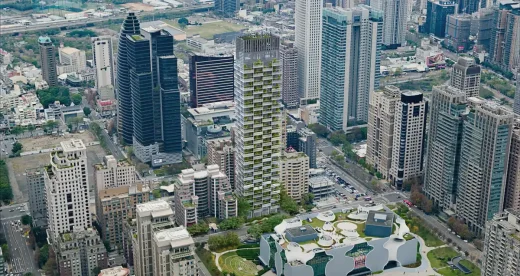
picture : ACPV ARCHITECTS
Green Utopia Tower Taichung building
Design: ODA
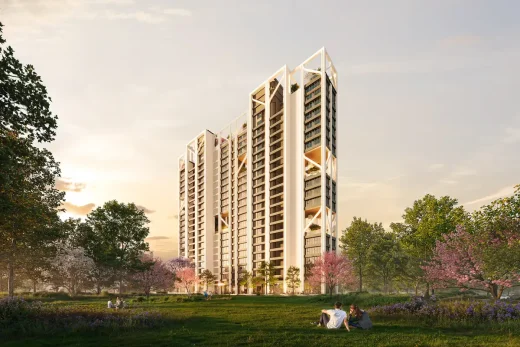
render : ODA
Compact Loft Studio, Taipei City
Design: fws_work
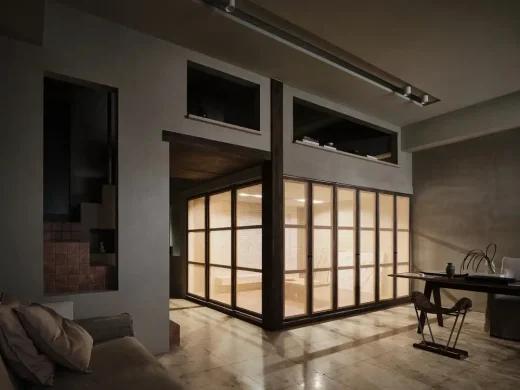
photo : Suiyu Studio
Hong Kong Walking Tours by e-architect – bespoke HK city walks
Comments / photos for the Market Cube, Zhubei, North District, Taiwan interior design by MVRDV page welcome

